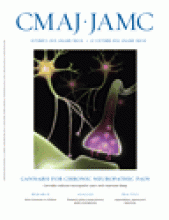Abstract
Background: Chronic neuropathic pain affects 1%–2% of the adult population and is often refractory to standard pharmacologic treatment. Patients with chronic pain have reported using smoked cannabis to relieve pain, improve sleep and improve mood.
Methods: Adults with post-traumatic or postsurgical neuropathic pain were randomly assigned to receive cannabis at four potencies (0%, 2.5%, 6% and 9.4% tetrahydrocannabinol) over four 14-day periods in a crossover trial. Participants inhaled a single 25-mg dose through a pipe three times daily for the first five days in each cycle, followed by a nine-day washout period. Daily average pain intensity was measured using an 11-point numeric rating scale. We recorded effects on mood, sleep and quality of life, as well as adverse events.
Results: We recruited 23 participants (mean age 45.4 [standard deviation 12.3] years, 12 women [52%]), of whom 21 completed the trial. The average daily pain intensity, measured on the 11-point numeric rating scale, was lower on the prespecified primary contrast of 9.4% v. 0% tetrahydrocannabinol (5.4 v. 6.1, respectively; difference = 0.7, 95% confidence interval [CI] 0.02–1.4). Preparations with intermediate potency yielded intermediate but nonsignificant degrees of relief. Participants receiving 9.4% tetrahydrocannabinol reported improved ability to fall asleep (easier, p = 0.001; faster, p < 0.001; more drowsy, p = 0.003) and improved quality of sleep (less wakefulness, p = 0.01) relative to 0% tetrahydrocannabinol. We found no differences in mood or quality of life. The most common drug-related adverse events during the period when participants received 9.4% tetrahydrocannabinol were headache, dry eyes, burning sensation in areas of neuropathic pain, dizziness, numbness and cough.
Conclusion: A single inhalation of 25 mg of 9.4% tetrahydrocannabinol herbal cannabis three times daily for five days reduced the intensity of pain, improved sleep and was well tolerated. Further long-term safety and efficacy studies are indicated. (International Standard Randomised Controlled Trial Register no. ISRCTN68314063)











